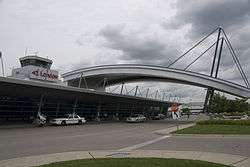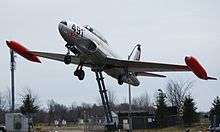London International Airport
| London International Airport | |||||||||||||||
|---|---|---|---|---|---|---|---|---|---|---|---|---|---|---|---|
 | |||||||||||||||
 London International Airport | |||||||||||||||
| Summary | |||||||||||||||
| Airport type | Public | ||||||||||||||
| Owner | Transport Canada[1] | ||||||||||||||
| Operator | Greater London International Airport Authority | ||||||||||||||
| Serves | London, Ontario | ||||||||||||||
| Location | London, Ontario | ||||||||||||||
| Time zone | EST (UTC−05:00) | ||||||||||||||
| • Summer (DST) | EDT (UTC−04:00) | ||||||||||||||
| Elevation AMSL | 912 ft / 278 m | ||||||||||||||
| Coordinates | 43°01′59″N 81°09′04″W / 43.0331°N 81.1511°WCoordinates: 43°01′59″N 81°09′04″W / 43.0331°N 81.1511°W | ||||||||||||||
| Website | www.flylondon.ca | ||||||||||||||
| Map | |||||||||||||||
 CYXU Location in Ontario  CYXU CYXU (Canada) | |||||||||||||||
| Runways | |||||||||||||||
| |||||||||||||||
| Statistics (2012) | |||||||||||||||
| |||||||||||||||
|
Sources: Canada Flight Supplement[2] Environment Canada[3] Movements from Statistics Canada[4] Passenger statistics from London Free Press.[5] | |||||||||||||||
London International Airport (IATA: YXU, ICAO: CYXU) is located 5 nautical miles (9.3 km; 5.8 mi) northeast of the city of London, Ontario, Canada.
In 2016, the airport handled 514,685 passengers,[5] and, in 2011, was the 20th busiest in Canada in terms of aircraft movements, with 94,747.[4] Air Canada Express, WestJet and WestJet Encore serve London International Airport. It also provides services for cargo airlines.
The airport is classified as an airport of entry by Nav Canada and is staffed by the Canada Border Services Agency (CBSA). CBSA officers at this airport can handle aircraft with no more than 180 passengers; however, they can handle up to 450 if the aircraft is unloaded in stages.[2]
History
London Airport, 1929-1942

In January 1927 the City of London selected a site for an airfield at Lambeth, Ontario near 42°55′00″N 081°17′00″W / 42.91667°N 81.28333°W. A group of local businessmen acquired the site in 1928 and by 3 May 1929 an airport license was issued to London Airport Ltd.[6] The London Flying Club was formed in 1928 and became a tenant of the new airport.[note 1] The airfield was used for flying instruction, private aviation, and for air mail. By 1933 it had become too small for some commercial aircraft.
The London Flying Club continued to use the Lambeth airfield until 7 August 1942.
London City Airport, 1940-1945
In 1935 the city decided to replace the original London Airport. Site surveys and consultations took place and on 9 September 1939, at the start of World War II, work began on a new airport located near Crumlin. The city leased the new airport to the Government of Canada, Department of Transport on 24 January 1940 for the duration of the war. Runways 14-32 and 05-23 were paved and ready for use by July 1940 and the Royal Canadian Air Force established RCAF Station Crumlin on part of the airport.[7][8] This air station was host to No. 3 Elementary Flying Training School(EFTS) and No. 4 Air Observer School(AOS), both part of the British Commonwealth Air Training Plan.
The airport remained under civilian management and was used for civil and military aviation during the war years. The licence for London City Airport was issued on 6 May 1941. Improvements made during this time include:
- main terminal building (civilian) opened in July 1942
- Trans-Canada Airlines began serve to the airport in July 1942.
- runway 08-26 added in 1943.
British Commonwealth Air Training Plan operations ended on 31 December 1944 with the closure of No. 4 Air Observer School.
After the war the airport remained under the control of the Department of Transport.[note 2]
Aerodrome Information
In approximately 1942 the aerodrome was listed at 43°02′N 81°09′W / 43.033°N 81.150°W with a Var. 5 degrees W and elevation of 899 feet (274 m). Two runways were listed as follows: [9]
| Runway Name | Total Length | Total Width | Paved Length | Paved Width |
|---|---|---|---|---|
| 5/23 | 3,400 feet (1,036 m) | 500 feet (152 m) | 3,150 feet (960 m) | 150 feet (46 m) |
| 4/22 | 3,400 feet (1,036 m) | 500 feet (152 m) | 3,150 feet (960 m) | 150 feet (46 m) |
Postwar RCAF operations 1945-1961

After World War II RCAF reserve or auxiliary squadrons were given the task of defending Canada's major cities.[10] 420 Squadron reformed as City of London 420 (Fighter) Auxiliary Squadron at the airport in September 1948. Initially equipped with Harvard aircraft, the squadron upgraded to Mustangs in 1952 and CT-133 jets in 1954. The squadron disbanded in 1957. Air Defence Command reformed 2420 Aircraft Control and Warning (Auxiliary) Squadron at London on 1 July 1956. 2420 trained Fighter Control operators and disbanded on 31 May 1961.
RCAF Station London opened in 1950 to support a NATO Induction and Training Centre, later moved to Centralia. The station closed on 30 September 1958.
As a tribute to this period, a Canadair T-33 aircraft in former Royal Canadian Air Force livery is mounted in front of the main terminal building.
Development since 1950-

The airport has been continuously improved since World War II as navigation and air traffic control systems evolved, and as commercial aircraft became larger and larger. These improvements include:
- 1950, installation of the Instrument Landing System (ILS) on runway 14-32
- 1955, runway 14-32 lengthened to 6,000 feet to accommodate the Vickers Viscount
- 1960, Meteorological Branch weather station opened
- 1965, new terminal building opened
- 1968, Air Canada begins DC-9 jet service
- 1974, runway 14-32 lengthened to 8,800 feet to accommodate DC-8, Boeing 707 and 747, and L-1011 aircraft
- 1988, runway 05-23 decommissioned
- 1990, new radar system installed
- 1998, control of the airport was transferred from Transport Canada to the Greater London International Airport Authority
- 2003, main terminal building completely renovated and expanded
Airlines and destinations
Passenger
| Airlines | Destinations |
|---|---|
| Air Canada Express | Montréal–Trudeau,[11] Ottawa, Toronto–Pearson |
| Air Transat | Seasonal: Cancún, Punta Cana |
| Canadian North | Charter: Halifax, Miami, Moncton, Saskatoon |
| Sunwing Airlines | Seasonal: Cayo Coco,[12] Montego Bay, Varadero |
| WestJet | Calgary Seasonal: Orlando, Winnipeg |
| WestJet Encore | Toronto–Pearson |
Other tenants
- CHC Helicopter — Ornge (Ontario Air Ambulance)
- Jet Aircraft Museum - The Jet Aircraft Museum currently operates 6 Canadair T-33 Silver Stars - otherwise known as the T-bird
- Executive Aviation — Esso-affiliated fixed-base operator
- Trek Aviation - Aircraft Maintenance and Consulting Services [13]
- B&W Aviation — Shell-affiliated fixed-base operator
- Diamond Aircraft — Light aircraft manufacturer
- Discovery Air — Niche flight services
- Diamond Flight Centre - Flight training school
- Forest City Flight Centre — Flight training school [14]
- AFS Aerial Photography — Aerial photography services
- Aero Academy (Recently closed)
- 427 (London) Wing - Air Force Association of Canada [15]
- International Test Pilots School
London International Airport Fire Crash and Rescue Station provides fire and rescue operations at the airport with three crash tenders based on Blair Boulevard.
Ground transportation
Shuttle service is available for passengers wishing to connect to flights at Toronto Pearson International Airport in Toronto.
London Transit Commission provides service between the airport and Fanshawe College.
Incidents
- On December 15, 2016, a Bombardier Dash 8, Air Canada Jazz Flight 8640, bound from London to Toronto slid off the runway into snow-covered grass following takeoff. It was snowing at the time of incident but the runway was reported to be in good condition. None of the 53 passengers or crew on board were injured. All passengers were transported back to the terminal and booked for flights later in the day.[16]
See also
Notes
- ↑ In 1927 the Government of Canada started a program to stimulate the growth of civil aviation through the creation of flying clubs. Groups that could provide a suitable airfield with facilities and at least 30 members were supplied with two aircraft and awarded $100 for each member who qualified as a pilot. The London Flying Club was established under this program.
- ↑ Many municipalities in Canada declined to accept responsibility for their airports after the war and so the Government of Canada, Department of Transport became the operator of most of the larger airports in the country.
References
- ↑ "The page has moved - La page a été déménagée". www.tc.gc.ca. Retrieved 25 March 2018.
- 1 2 Canada Flight Supplement. Effective 0901Z 19 July 2018 to 0901Z 13 September 2018.
- ↑ Synoptic/Metstat Station Information Archived 2011-12-01 at the Wayback Machine.
- 1 2 "Aircraft Movement Statistics: NAV CANADA Towers and Flight Service Stations: Annual Report (TP 577): Table 2-1 — Total aircraft movements by class of operation — NAV CANADA towers". www.statcan.gc.ca. Retrieved 25 March 2018.
- 1 2 "London International Airport sees traveller tally take off". lfpress.com. 27 January 2017. Retrieved 25 March 2018.
- ↑ McGrath, T.M. (1992). History of Canadian Airports (2nd ed.). Ottawa: Lugus Publications in co-operation with Transport Canada. ISBN 0-921633-11-4.
- ↑ Hatch, F. J. (1983).The Aerodrome of Democracy: Canada and the British Commonwealth Air Training Plan, 1939-1945. Ottawa: Directorate of History, Department of National Defence. ISBN 0660114437>
- ↑ Military Bruce Historical Writings by Bruce Forsyth Archived 2013-10-23 at the Wayback Machine.
- ↑ Staff writer (c. 1942). Pilots Handbook of Aerodromes and Seaplane Bases Vol. 1. Royal Canadian Air Force. p. 132.
- ↑ anonymous. "Air Reserve". Canadian Forces. Retrieved 19 Nov 2014.
- ↑ Air Canada to Launch Daily non-stop Montreal-London, Ontario and Montreal-Windsor, Ontario flights aircanada.com. Retrieved 25 April 2018.
- ↑ "BlackburnNews.com - New Flight From London To Cuba". blackburnnews.com. Retrieved 25 March 2018.
- ↑ "Trek Aviation". www.trekaviation.com. Retrieved 25 March 2018.
- ↑ Group, Data Recovery. "Forest City Flight Centre - CYXU London Airport". forestcityflightcentre.com. Retrieved 25 March 2018.
- ↑ "427 (London) Wing". 427wing.com. Retrieved 25 March 2018.
- ↑ nurun.com. "Plane slides off runway". The London Free Press. Retrieved 2016-12-15.
External links
| Wikimedia Commons has media related to London International Airport. |
- Past three hours METARs, SPECI and current TAFs for London International Airport from Nav Canada as available.